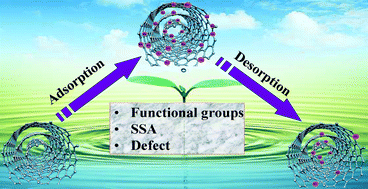Surface functional groups and defects on carbon nanotubes affect adsorption–desorption hysteresis of metal cations and oxoanions in water†
Abstract
This study investigated the influence of the structure characteristics of carbon nanotubes (CNTs), such as surface oxygen-containing functional groups, specific surface area (SSA) and concentration of defects, on the adsorption–desorption hysteresis of a metal cation (Cu(II)) and two oxoanions (As(V) and Cr(VI)), from single, double and multi-walled CNTs (SWCNTs, DWCNTs and MWCNTs), and two oxidized MWCNTs with different oxygen concentrations (MWCNTs-O1, 2.51 wt% O and MWCNTs-O2, 3.5 wt% O). Oxygen-containing functional groups contributed to an increase in the adsorption capacity for Cu(II) from aqueous solutions, but a decrease in adsorption capacity for Cr(VI) and As(V). The order of adsorption capacities based on CNT SSA was MWCNTs-O2 > MWCNTs-O1 > MWCNTs > DWCNTs > SWCNTs, which was consistent with the order of CNT defect contents. Desorption hysteresis index (HI) values for Cu(II) increased as the number of functional groups increased. For Cr(VI) and As(V), however, HI values decreased as the number of functional groups increased. HI values decreased with an increase in metal ion surface coverage on CNTs. There may be a shift in the mechanisms of metal ion adsorption by CNTs, from more irreversible to more reversible processes, with an increase in adsorbed metal ions. An understanding of the desorption hysteresis of heavy metal ions is important and useful for the application and risk assessment of CNTs in the natural environment.


 Please wait while we load your content...
Please wait while we load your content...